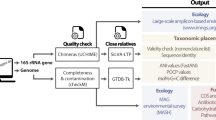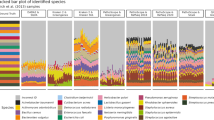Abstract
Amplified marker-gene sequences can be used to understand microbial community structure, but they suffer from a high level of sequencing and amplification artifacts. The UPARSE pipeline reports operational taxonomic unit (OTU) sequences with ≤1% incorrect bases in artificial microbial community tests, compared with >3% incorrect bases commonly reported by other methods. The improved accuracy results in far fewer OTUs, consistently closer to the expected number of species in a community.
This is a preview of subscription content, access via your institution
Access options
Subscribe to this journal
Receive 12 print issues and online access
$259.00 per year
only $21.58 per issue
Buy this article
- Purchase on Springer Link
- Instant access to full article PDF
Prices may be subject to local taxes which are calculated during checkout


Similar content being viewed by others
References
Human Microbiome Project Consortium. Nature 486, 207–214 (2012).
Lundberg, D.S. et al. Nature 488, 86–90 (2012).
Bokulich, N.A. et al. Nat. Methods 10, 57–59 (2013).
Quince, C. et al. Nat. Methods 6, 639–641 (2009).
Reeder, J. & Knight, R. Nat. Methods 7, 668–669 (2010).
Quince, C., Lanzen, A., Davenport, R.J. & Turnbaugh, P.J. BMC Bioinformatics 12, 38 (2011).
Edgar, R.C., Haas, B.J., Clemente, J.C., Quince, C. & Knight, R. Bioinformatics 27, 2194–2200 (2011).
Huse, S.M., Welch, D.M., Morrison, H.G. & Sogin, M.L. Environ. Microbiol. 12, 1889–1898 (2010).
Schloss, P.D., Gevers, D. & Westcott, S.L. PLoS ONE 6, e27310 (2011).
Caporaso, J.G. et al. Nat. Methods 7, 335–336 (2010).
Sneath, P.H.A. & Sokal, R.R. Numerical Taxonomy (W.H. Freeman, 1973).
Haas, B.J. et al. Genome Res. 21, 494–504 (2011).
Human Microbiome Project Consortium. Nature 486, 215–221 (2012).
Ihrmark, K. et al. FEMS Microbiol. Ecol. 82, 666–677 (2012).
DeSantis, T.Z. et al. Appl. Environ. Microbiol. 72, 5069–5072 (2006).
Masella, A.P., Bartram, A.K., Truszkowski, J.M., Brown, D.G. & Neufeld, J.D. BMC Bioinformatics 13, 31 (2012).
Sayers, E.W. et al. Nucleic Acids Res. 40, D13–D25 (2012).
Acknowledgements
The author thanks N.A. Bokulich, J.G. Caporaso and D. Gevers for helpful discussions and providing prepublication data; P.D. Schloss for assistance with mothur; C. Quince for assistance with AmpliconNoise; L. Dethlefsen and S.M. Huse for helpful discussions; S. Yourstone for an insightful critique of a draft manuscript; and the Sloan Foundation, Microbiology of the Built Environment Program (M.L. Sogin, Marine Biological Laboratory) for providing compute resources.
Author information
Authors and Affiliations
Contributions
R.C.E. conceived of the study, performed the analysis and wrote the manuscript.
Corresponding author
Ethics declarations
Competing interests
The author declares no competing financial interests.
Supplementary information
Supplementary Text and Figures
Supplementary Notes 1–3 (PDF 1505 kb)
Supplementary Software
UPARSE pipeline (TAR 1350 kb)
Rights and permissions
About this article
Cite this article
Edgar, R. UPARSE: highly accurate OTU sequences from microbial amplicon reads. Nat Methods 10, 996–998 (2013). https://doi.org/10.1038/nmeth.2604
Received:
Accepted:
Published:
Issue Date:
DOI: https://doi.org/10.1038/nmeth.2604
This article is cited by
-
Intestinal microbiota and metabolome perturbations in ischemic and idiopathic dilated cardiomyopathy
Journal of Translational Medicine (2024)
-
Integrated characterization of filler tobacco leaves: HS–SPME–GC–MS, E-nose, and microbiome analysis across different origins
Bioresources and Bioprocessing (2024)
-
Ganoderma lucidum polysaccharide ameliorates cholesterol gallstone formation by modulating cholesterol and bile acid metabolism in an FXR-dependent manner
Chinese Medicine (2024)
-
Solobacterium moorei promotes the progression of adenomatous polyps by causing inflammation and disrupting the intestinal barrier
Journal of Translational Medicine (2024)
-
Growth performance, nutrient digestibility, fecal microbial diversity and volatile fatty acid, and blood biochemical indices of suckling donkeys fed diets supplemented with multienzymes
BMC Veterinary Research (2024)



